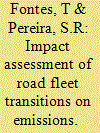|
|
|
Sort Order |
|
|
|
Items / Page
|
|
|
|
|
|
|
| Srl | Item |
| 1 |
ID:
104921


|
|
|
|
|
| Publication |
2011.
|
| Summary/Abstract |
This study deals with the estimation of emissions caused by vehicular traffic based on transport demand and energy consumption. Projected transport demand is calculated with Genetic Algorithm (GA) using population, gross domestic product per capita (GDPPC) and the number of vehicles. The energy consumption is modelled with the GA using the veh-km. The model age of the vehicles and their corresponding share for each year using the reference years is obtained. The pollutant emissions are calculated with estimated transport and energy demand. All the calculations are made in line to meet the European standards. For this purpose, two cases are composed. Case 1: Emissions based on energy consumption, and Case 2: Emissions based on transport demand. The both cases are compared. Three policies are proposed to control demand and the emissions. The policies provided the best results in terms of minimum emissions and the reasonable share of highway and railway mode as 70% and 30% usage for policy I, respectively. The emission calculation procedure presented in this study would provide an alternative way to make policies when there is no adequate data on emission measurement in developing countries.
|
|
|
|
|
|
|
|
|
|
|
|
|
|
|
|
| 2 |
ID:
132609


|
|
|
|
|
| Publication |
2014.
|
| Summary/Abstract |
This paper aims to examine the impacts of fleet composition changes on emission due to the introduction of different road transportation policies in a medium size European country (Portugal) applying an ex-post analysis (e.g. policies based on fuel pricing, car scraping, car taxation). A baseline scenario was compared with a counterfactual scenario in order to understand what would occur in the absence of the introduction of those policies. For each scenario, four approaches were assessed using economic effects and/or human health costs. HC, CO, NOx, PM and CO2 emissions from passenger cars and light duty vehicles were evaluated. The results show high statistical significance (p?0.05) between CO emissions and different vehicle features as vehicle age, fuel type and engine classes. The same pattern was observed between the average vehicle age and HC, NOx and PM. After the implementation of road traffic policies, the average emission factors of the fleet decreased 28-62% for HC, CO, NOx, PM and 20-39% for CO2. However, if a counterfactual scenario would be implemented, the reduction would be 20-80% and 26-55% higher, respectively. The results demonstrates that although were recorded some benefits, the fleet characteristics distribution were more environmental friendly in 2001 than in 2011.
|
|
|
|
|
|
|
|
|
|
|
|
|
|
|
|
| 3 |
ID:
111342


|
|
|
|
|
| Publication |
2012.
|
| Summary/Abstract |
The need to reduce oil consumption and greenhouse gases is driving a fundamental change toward more efficient, advanced vehicles, and fuels in the transportation sector. The paper reviews the current status of light duty vehicles in the US and discusses policies to improve fuel efficiency, advanced electric drives, and sustainable cellulosic biofuels. The paper describes the cost, technical, infrastructure, and market barriers for alternative technologies, i.e., advanced biofuels and light-duty vehicles, including diesel vehicles, natural-gas vehicles, hybrid electric vehicles, plug-in hybrid electric vehicles, and fuel-cell electric vehicles. The paper also presents R&D targets and technology validation programs of the US government.
|
|
|
|
|
|
|
|
|
|
|
|
|
|
|
|
|
|
|
|
|